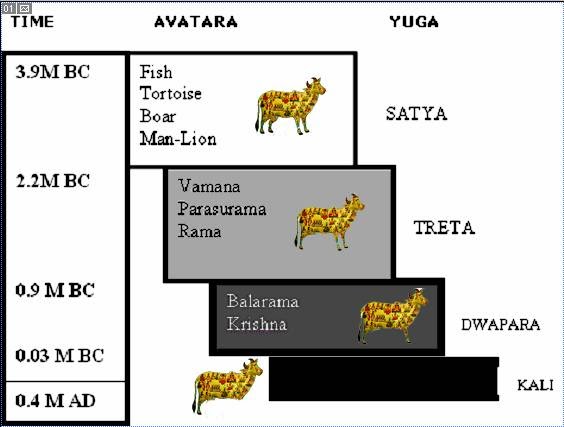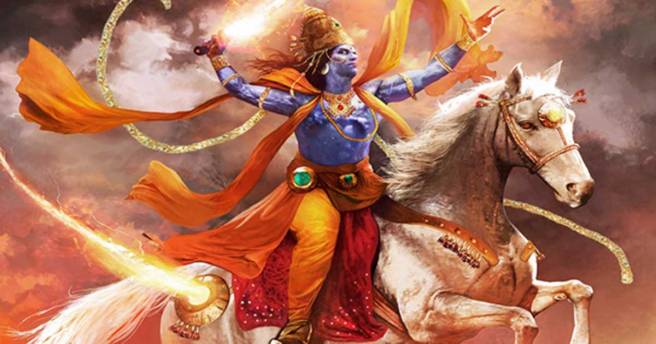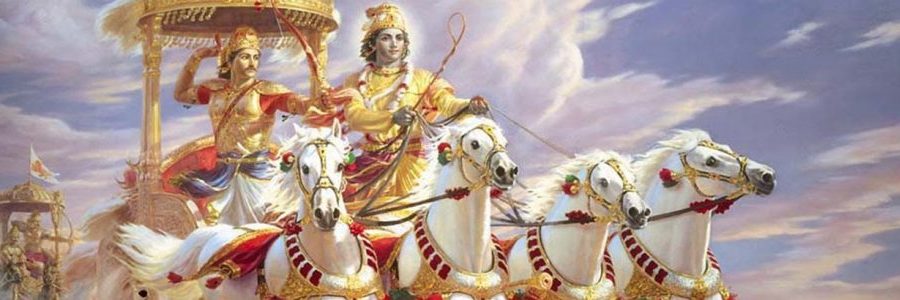The Four Yugas
The Vedas and Puranas describe the progress of time as a cycle of universal creation and destruction. According to the Law of Manu, the oldest known text to describe the Hindu concept of cosmic time, each cycle, or mahayuga, is the equivalent to one day for Lord Brahma, and is roughly equal to 4,320,000 human years. Once a mahayuga comes to an end, a new mahayuga begins and the cycle of time repeats itself.
Each mahayuga is broken into the four yugas listed below:
- Satya Yuga
- Treta Yuga
- Dvapara Yuga
- Kali Yuga

Satya Yuga, or the Age of Truth, is the first and foremost of the four yugas, spanning 1,728,000 human years. Also known as the Golden Age, Satya Yuga is known as the age in which virtue reigned supreme, peace ruled the land, and dharma was upheld to the highest standard. The bull of dharma stood firmly on all four legs during Satya Yuga. Each varna served their sanatana dharma dutifully. Brahmins studied the Vedas and Puranas with utmost devotion and piety, Kshatriyas protected their subjects and kingdoms with sincerety, Vaishyas engaged in fair trade and honest business, and Shudras wholeheartedly served the other varnas. The varna system functioned flawlessly, without corruption or oppression.
During Satya Yuga, all were inclined toward wisdom and supreme knowledge, which they sought to learn through penance and devotion to God. Religion was at the center of all activities, and the Vedas were regarded with utmost respect and piety. Sages were incredibly powerful and strong, capable of living for thousands of years and siring thousands of children. Every word they uttered had immense power and could decide the fate of even the gods themselves.
Treta Yuga, spanning 1,296,000 years, is the next yuga in the cosmic cycle. The Treta Yuga, while still dominated by virtue, started showing the decline of dharma. The bull of dharma now stood on three legs, the fourth leg having been severed by sin. The power of humans during Treta Yuga slightly diminished, as did their life span and penance. People grew more materialistic and less spiritual. Brahmins and Kshatriyas became more concerned with fulfilling their desires rather than devoting themselves to the Vedas and their kingdoms respectively. Systems of law were derived during the Treta Yuga in order to keep society under control.
Dvapara Yuga is the third yuga, spanning 864,000 years. The decline of virtue and accumulation of sin became particularly pronounced during Dvapara Yuga. The bull of dharma now only stood on two legs. Humans of this yuga weren’t as powerful as their ancestors. Disease and war was rampant. People became more selfish and greedy for power. The varna system became a corrupt system in which the Brahmin and Kshatriya varnas developed a sense of superiority and looked down upon other varnas. Families and blood relatives fought over material and worldly possessions. In fact, the famed Kurukshetra War of the Mahabharata took place because of a family dispute over political power.
Kali Yuga, the Age of Darkness, is the last of the four yugas and is the yuga in which we currently reside. Kali Yuga began approximately 5,000 years ago, on the very day that Sri Krishna returned to His Heavenly Abode. Spanning 432,000 years, Kali Yuga is reigned by Kali, the asura of all evil and the personification of adharma. True to its namesake, Kali Yuga represents the accumulation of mankind’s sin and adharma over the past three yugas. Human civilization deteriorates spiritually and morally during the Kali Yuga. War, disease, crime, and corruption are widespread across all varnas. Brahmins are no longer honored or learned, Kshatriyas are no longer brave, Vaishyas are no longer fair in their dealings, and the varna system will fall apart. Wealth is no longer measured in virtue, but rather in material possessions. Religion has been reduced to superficiality and inferiority in this age. People involve themselves extensively in immoral behaviors. Relations between family degrade completely; even fellow brothers will kill each other for material possessions. The bull of dharma now stands on a single leg, having only a quarter of the virtue that existed in Satya Yuga. And by the end of the Kali Yuga, the one remaining leg of the bull will also be severed by sin.
Prophesied Events During Kali Yuga
The Bhagavata Purana, written 5,000 years ago by Sage Vedavyasa, predicts with surprising accuracy the events that will happen during the Kali Yuga. Canto 12, Chapter 2 of the Bhagavata Purana makes the following predictions about the decline of civilization during Kali Yuga:
- Wealth alone will be considered the sign of a man’s good birth, proper behavior, and fine qualities.
- Law and justice will be applied only on the basis of one’s power.
- Men and women will live together merely on the basis of physical attraction.
- Womanliness and manliness will only be determined by one’s expertise in sex.
- A person’s spiritual position will be ascertained merely according to external symbols, and on this basis, people will change from one spiritual order to the next.
- A person’s moral standing will be critically considered if he does not earn a good living. He who does not have money will be judged as unholy.
- Those who are clever at juggling words will be considered learned scholars.
- Marriage will be arranged simply by verbal agreement.
- Beauty will be thought to depend on one’s hairstyle.
- Filling the belly will become the goal of life.
- One who is audacious will be accepted as truthful.
- The principles of religion will be observed only for the sake of reputation.
- Citizens will lose their wives and properties to avaricious and merciless rulers, who will act no better than ordinary thieves.
- People will be harassed by famine, struck by drought, and ruined by excessive taxes.
- Cities will be dominated by thieves.
- The Vedas will be contaminated by speculative interpretations of atheists.
- Political leaders will virtually consume the citizens.
- So-called priests and intellectuals will be devotees of their bellies and genitals.
- Servants will abandon a master who has lost his wealth, even if that master is a saintly person of exemplary character. Likewise, masters will abandon an incapacitated servant, even if that servant has been in the family for generations.
- Cows will be abandoned or killed when they stop giving milk.
- Uncultured men will accept charity on behalf of the Lord, and will earn their livelihood by making a show of their austerity.
- Those who know nothing about religion will mount a high seat and presume to speak on religious principles.
- In Kali Yuga, men will develop hatred for each other even over a few coins.
- People will be ready to lose their own lives and kill even their own relatives.
- Men will no longer protect their elderly parents.
- Religion, truthfulness, cleanliness, tolerance, mercy, duration of life, physical strength, and memory will all diminish day by day.
Incarnations of Lord Vishnu Across the Yugas
During Satya Yuga and Treta Yuga, Lord Vishnu came down to Earth as seven different incarnations, including Varaaha, Narasimha, Vamana, and Sri Rama. Each of these incarnations were created in order to combat the evil asuras Hiranyaksha, Hiranyakashipu, Bali, and Ravana respectively. These asuras were the biggest threat to mankind and to the balance of virtue in the universe, so Lord Vishnu Himself had to come down to Earth to defeat them.
During Dvapara Yuga, Lord Vishnu descended to earth as Sri Krishna and defeated Shishupala and Dantavakra. However, these asuras were no longer the primary threat to the balance of virtue. Virtue’s biggest threat now was mankind’s decline of morality. The reason for Lord Vishnu’s incarnation was not to combat the asuras, but rather to combat the sin that was accumulating on Earth. He had to save mankind before it destroyed itself, so he sought to teach mankind about its virtues. He taught about the nature of morality, the battle between good and evil, the importance of dharma, and the impermanence of worldly ties. These lessons were compiled into the Srimad Bhagavad Gita. By reading the Bhagavad Gita and applying its lessons to our daily lives, we can combat our sin and live virtuously.

Just as Lord Vishnu came down to Earth in past yugas to save mankind from evil, it is foretold that He will descend again to save us from the darkness of Kali Yuga. As the Kali Yuga progresses, virtue will slowly wither away and error will take its place. Once the end of Kali Yuga arrives and the last leg on the bull of dharma is severed by civilization’s sin, Lord Vishnu himself will incarnate on Earth as Sri Kalki, the tenth and last avatar, to destroy all evil and immorality.
ittham kalau gata-praye
janesu khara-dharmisu
dharma-tranaya sattvena
bhagavan avatarisyati
Thus when the age of Kali is almost finished and all human beings will have become like asses, at that time the Supreme Lord will appear on the Earth. Acting with the power of pure spiritual goodness, He will rescue eternal religion. (Srimad Bhagavatam 12.2.17)
Sri Kalki will mount atop a white horse, Devadatta, and with sword in hand, he will blaze like a comet across the Earth, destroying all cruelty and filth. Sri Kalki will restore peace, and all sins accumulated from the four yugas will be forgiven by Him. At this moment, Kali Yuga will end and a new Satya Yuga will commence. The cosmic cycle will come full-circle.

Until Sri Kalki Arrives
It is expected that Sri Kalki will not arrive until the end of Kali Yuga, which is still 427,000 years from now. In the mean time, how can we protect ourselves from the sin of Kali Yuga and live as honorably as we can?
kaler dosha-nidhe rajann
asti hy eko maha gunah
kirtanad eva krishnasya
mukta-sangah param vrajet
Although Kali-yuga is an ocean of faults, there is still one good quality about this age: simply by chanting the names of Krishna, one can become free from material bondage and be promoted to the transcendental kingdom. (Source: Srimad Bhagavatam 12.3.51)
By devoting ourselves to the Lord and incorporating His lessons [from the Bhagavad Gita] of virtue and faith into our daily lives, we can be cleansed of our sin and spread goodness in the world.
